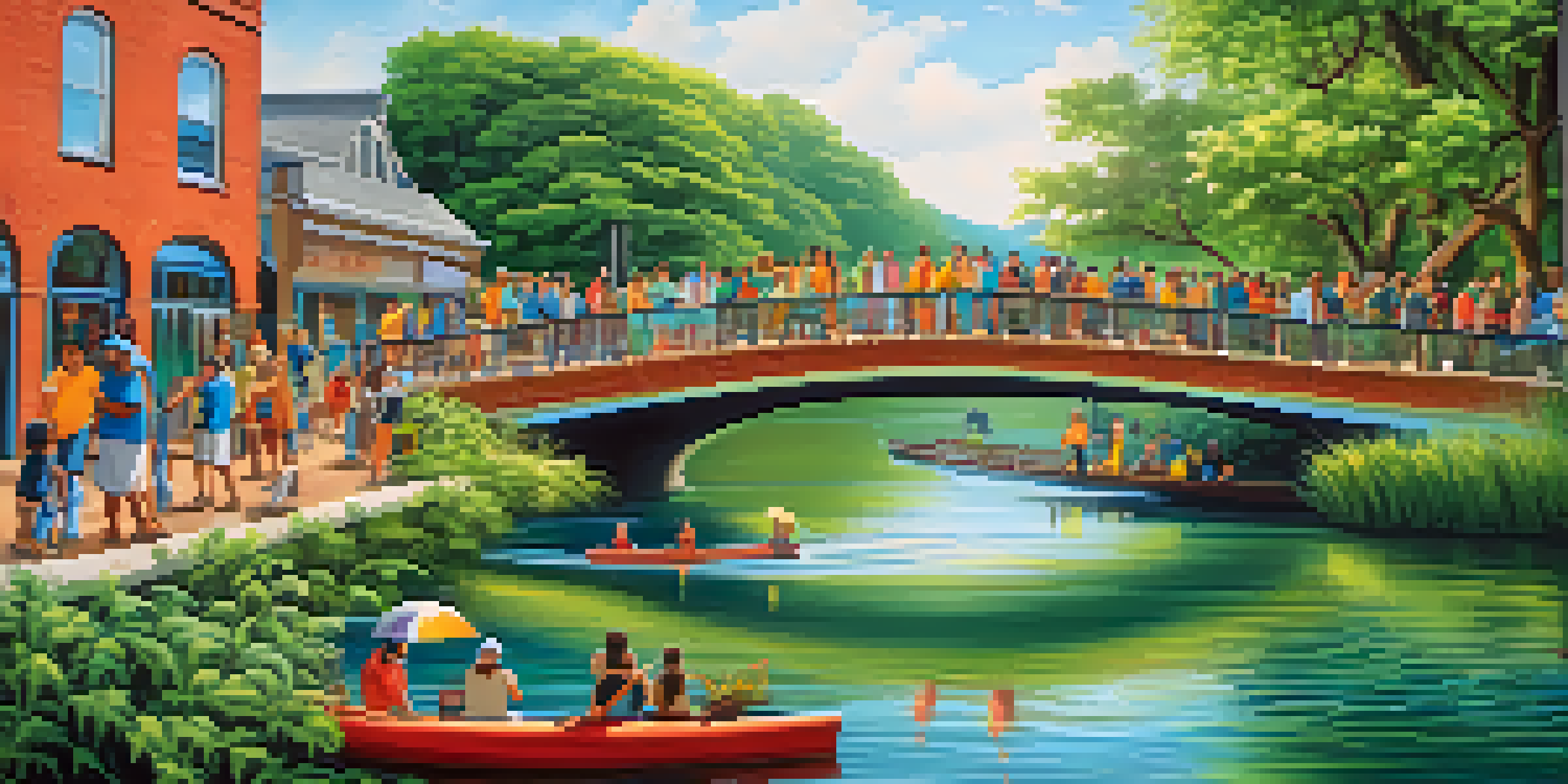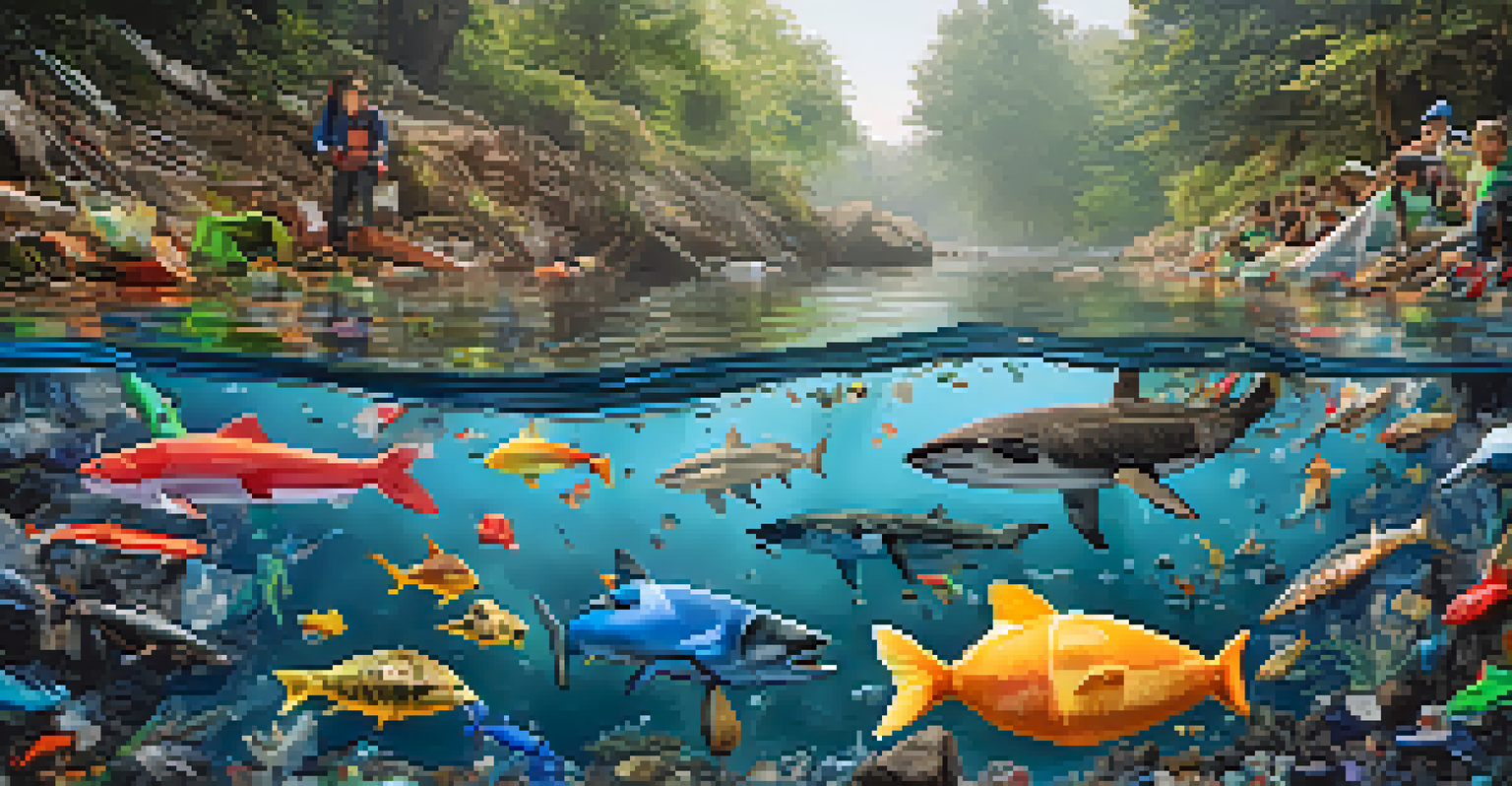The Impact of Pollution: Artistic Responses to Contamination

Understanding Pollution and Its Environmental Impact
Pollution is a pressing issue that affects our ecosystems, health, and climate. It includes various forms like air, water, and soil contamination, each leaving a significant mark on our environment. For instance, plastic waste in oceans not only harms marine life but also disrupts delicate ecosystems, leading to long-term consequences. As awareness grows, the urgency to combat pollution becomes more pronounced, sparking discussions around solutions and artistic expressions.
Art is not a mirror to hold up to society, but a hammer with which to shape it.
The impact of pollution often goes beyond physical damage; it penetrates the cultural and emotional fabric of communities. Many people feel a sense of loss or helplessness when witnessing the degradation of their surroundings. This emotional weight can be a powerful motivator for artists, who channel these feelings into their work. By translating their concerns into visual narratives, they can engage audiences and foster a deeper understanding of the issue.
Artists serve as both observers and activists, using their platforms to highlight pollution's stark realities. Through their creations, they challenge viewers to reflect on their relationship with the environment. Whether through paintings, sculptures, or installations, these artistic responses can provoke thought, inspire action, and even spark movements aimed at environmental protection.
Art as a Reflection of Environmental Concerns
Art often mirrors societal issues, and pollution is no exception. Artists have the unique ability to capture the essence of their time, making their work a powerful reflection of current environmental concerns. For instance, contemporary installations featuring discarded plastics raise awareness about waste and encourage viewers to rethink their consumption habits. This reflection prompts a collective dialogue around the importance of sustainability.

Moreover, art can evoke emotions that statistics and reports often fail to convey. A striking image of a polluted river or a poignant sculpture made from recycled materials can leave a lasting impression. When viewers connect emotionally with a piece, they are more likely to take action, whether that means advocating for change or altering their personal habits. This emotional impact is crucial in nurturing a culture of environmental stewardship.
Art Sparks Dialogue on Pollution
Artists use their work to engage audiences and provoke discussions about environmental issues, making pollution a relatable concern.
Additionally, art can serve as a form of protest against environmental degradation. Artists often utilize their work to challenge corporations or governments that contribute to pollution. By making bold statements through their art, they can galvanize communities to take a stand and push for policy changes. This intersection of art and activism underscores the potential for creativity to drive social change.
Highlighting Local Pollution Through Community Art Projects
Community art projects are a vibrant way to address local pollution issues while fostering collaboration among residents. These initiatives often involve workshops where community members come together to create murals or sculptures that reflect their shared concerns about pollution in their area. For example, a neighborhood might come together to design a mural depicting the local waterway's beauty, emphasizing the urgent need for its preservation. This collective effort can strengthen community bonds and instill a sense of pride.
The greatest threat to our planet is the belief that someone else will save it.
Involving local artists and residents allows for a diversity of perspectives, enriching the final artwork. Participants often share personal stories related to their experiences with pollution, which can deepen the impact of the project. This shared narrative not only highlights the environmental challenges faced but also celebrates the resilience and creativity of the community. Ultimately, these projects can transform public spaces into platforms for awareness and change.
Furthermore, community art projects can attract attention from local media and policymakers. When a vibrant mural or installation captures the community's spirit, it can spark conversations beyond the neighborhood. This visibility can lead to increased funding for environmental initiatives or inspire similar projects in other areas. By elevating local voices, these artistic endeavors play a crucial role in the broader movement against pollution.
The Role of Performance Art in Addressing Pollution
Performance art is another compelling medium through which artists address pollution. This form of art combines visual elements with live action, creating immersive experiences that can captivate audiences. For instance, a performance that incorporates movement through polluted landscapes can vividly illustrate the physical and emotional toll of environmental degradation. These performances can leave a profound impact, prompting viewers to reconsider their environmental responsibilities.
Additionally, performance art often allows for direct engagement with the audience, making the message even more powerful. When viewers witness a performance that embodies the struggles of polluted environments, they may feel compelled to reflect on their own actions. This interactive nature of performance art creates an opportunity for dialogue, encouraging participants to discuss pollution and its effects more openly.
Community Art Builds Local Awareness
Community art projects unite residents to address local pollution, fostering collaboration and a sense of pride in their environment.
Moreover, performance art can be a dynamic tool for activism. Artists often use their performances to draw attention to specific issues, rallying support for environmental causes. By staging events in public spaces, they can reach a broader audience and engage passersby in conversations about pollution. This blend of art and activism can amplify the urgency of the message and inspire collective action.
Using Digital Art to Raise Awareness About Pollution
In today's digital age, artists are harnessing technology to address pollution in innovative ways. Digital art allows for the creation of engaging visuals that can be easily shared across social media platforms, reaching a global audience. For example, animated videos that illustrate the journey of plastic waste can effectively communicate the urgency of reducing single-use plastics. This ability to spread awareness quickly is one of the greatest strengths of digital art.
Moreover, digital art can create interactive experiences that invite audiences to engage with the subject matter. Virtual reality installations, for instance, can transport viewers to polluted environments, allowing them to witness the impact of pollution firsthand. This immersive experience can evoke empathy and motivate individuals to take action in their own lives, from reducing waste to advocating for policy changes.
Additionally, digital art often incorporates data visualization, presenting pollution statistics in visually compelling ways. By transforming complex data into accessible graphics, artists can help demystify the scale of pollution and its consequences. This clarity can foster a deeper understanding of the issue and encourage viewers to become advocates for environmental change.
Exploring Eco-Art as a Movement Against Pollution
Eco-art is a burgeoning movement where artists create works that prioritize environmental sustainability. This genre often focuses on using recycled materials or natural elements to create art, challenging traditional notions of beauty and value. For example, artists might craft sculptures from found objects or create installations that highlight the beauty of native plants. By embracing eco-friendly practices, these artists not only raise awareness about pollution but also inspire others to consider their own environmental impact.
Moreover, eco-art often emphasizes the interconnectedness of nature and humanity. Many eco-artists aim to remind us that our actions have direct consequences on the environment. Through their work, they illustrate how pollution disrupts natural habitats and affects wildlife. This narrative can spark conversations about the importance of biodiversity and the need for conservation efforts.
Digital Art Expands Reach on Issues
Utilizing technology, digital art effectively raises global awareness about pollution, encouraging action through engaging visuals.
Additionally, eco-art can serve as a call to action, urging communities to engage in sustainable practices. Artists may collaborate with local organizations to promote clean-up events or tree-planting initiatives. By integrating their art with community activism, these artists create a holistic approach to addressing pollution, fostering a sense of responsibility and stewardship for the environment.
The Future of Artistic Responses to Pollution
As awareness of pollution continues to grow, the future of artistic responses looks promising and dynamic. Artists are likely to explore even more innovative ways to address environmental concerns, using emerging technologies and mediums. For example, we might see more interactive installations that utilize augmented reality to educate viewers about pollution's impact in real-time. This blend of art and technology can create powerful experiences that resonate with audiences.
Moreover, the collaboration between artists and scientists is becoming increasingly important. By working together, they can communicate complex environmental issues in accessible and engaging ways. This partnership can result in impactful projects that not only educate the public but also contribute to real-world solutions. Artists can bring attention to scientific findings, while scientists can provide artists with the data needed to inform their work.

Ultimately, as artists continue to respond to pollution through their creativity, they play a vital role in shaping public discourse. Their work can inspire individuals and communities to take action, fostering a culture of environmental awareness and responsibility. As we move toward a more sustainable future, the intersection of art and environmentalism will undoubtedly remain a powerful force for change.